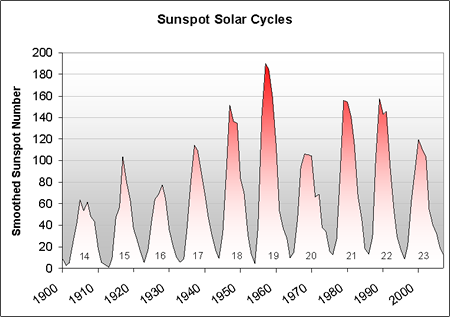
| {column0} |
| {column0} |
So WHY does the Sun, and every other star for that matter, have a hot outer atmosphere that incubates and produces space weather?
The clue to the solution of this puzzle lies back with those little dark areas we call sunspots.
Sunspots are dark, cooler areas on the solar surface that contain strong, constantly shifting magnetic fields. A moderate-sized sunspot is many times larger than the size of the Earth. Sunspots form over periods lasting from days to weeks, and can persist for weeks and even months before dissipating. The average number of sunspots regularly wax and wane in an 11-year sunspot cycle. Sunspots occur when strong magnetic fields emerge through the solar surface and allow the area to cool slightly, from a background value of 6000°K down to about 4200°K. This cooler area appears as a dark spot on the Sun. As the Sun rotates, sunspots on its surface appear to move from left to right (from east to west). It takes the Sun 27 days to make one complete rotation.
11-Year Sunspot Cycle

Again, the average number of sunspots regularly wax and wane in an 11-year sunspot cycle.
This sunspot cycle is a useful way to mark the changes in the Sun. Solar Minimum refers to the several Earth years when the number of sunspots is lowest; Solar Maximum occurs in the years when sunspots are most numerous. During Solar Maximum, activity on the Sun and its effects on our technology are high.